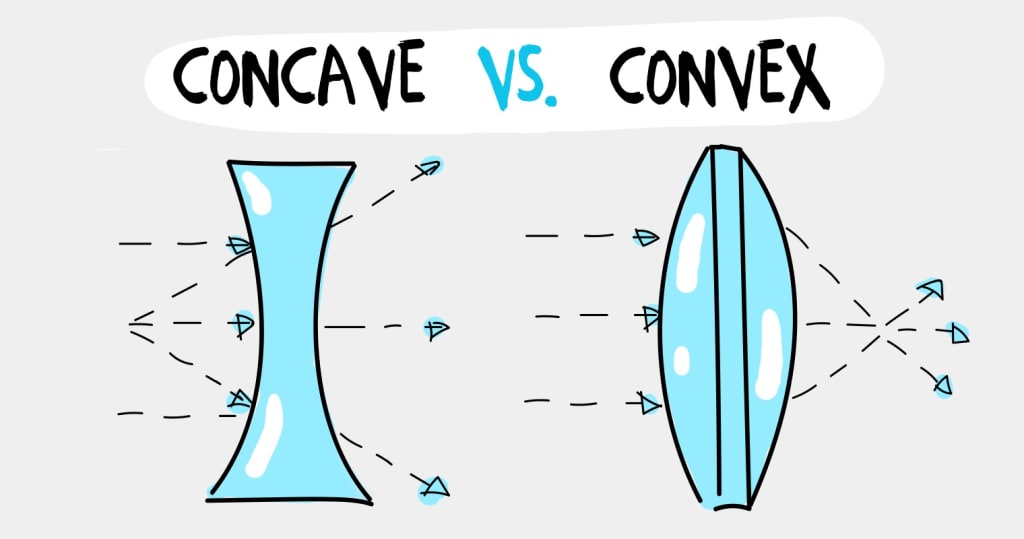Learn the Difference Between Concave and Convex Mirrors
Difference Between Concave and Convex Mirrors

Mirrors are not all the same, and their differences are more than just aesthetic. The shape of a mirror can drastically change the type of image it reflects. Two major types of mirrors, concave and convex, offer unique characteristics due to their shapes. To understand these two types of mirrors, we will dive deep into their definitions, differences, and specific characteristics.
What are Concave and Convex Mirrors?
Concave and convex mirrors are types of curved mirrors that are differentiated based on their surfaces curving inwards or outwards.
Concave Mirrors: A concave mirror, also known as a converging mirror, has a reflective surface that curves inward. Think of it as a cave; it's hollow and recessed. The curving inwards means that light rays hitting the mirror converge at a particular point known as the focus. This mirror is used in applications where magnified images are required, such as telescopes, car headlamps, and shaving mirrors.
Convex Mirrors: On the other hand, a convex mirror, known as a diverging mirror, has a reflective surface that curves outward, away from incoming light. This causes light rays to spread out or diverge. Convex mirrors provide a wider field of view, making them useful in car side mirrors, security mirrors in shops, and rear-view mirrors in vehicles.
Difference between Concave and Convex Mirror
While both are curved mirrors, there are several difference between concave and convex mirror, particularly in their shape, the type of image they form, and their applications.
Shape: The fundamental difference is the direction of the curve. In a concave mirror, the reflective surface curves inward, creating a recessed or hollow shape. In contrast, a convex mirror curves outward, creating a bulged or protruded shape.
Image Formation: In concave mirrors, the image can be either real (can be projected on a screen) or virtual (cannot be projected), inverted, or upright, depending on the position of the object. However, in convex mirrors, the image is always virtual and erect, regardless of the object's position.
Field of View: Convex mirrors provide a broader field of view compared to concave mirrors. This is due to the outward curvature that causes light rays to diverge upon reflection.
Applications: Due to these differences, they are used in different applications. Concave mirrors are used in car headlamps, dental mirrors, and telescopes for their magnification and focusing properties. On the other hand, convex mirrors are used for security purposes, vehicle side mirrors, and road safety mirrors due to their wider field of view.
Characteristics of Concave Mirrors:
Focal Point: All light rays parallel to the principal axis converge at a point known as the focal point in a concave mirror.
Magnification: They can produce magnified images. When an object is placed close to the mirror (within the focal length), a magnified and virtual image is formed.
Image Formation: Depending on the position of the object, the image can be real and inverted, or virtual and upright. Real images are formed when the object is placed beyond the focal point, while virtual images are formed when the object is placed between the mirror and the focal point.
Reflective Properties: The concave mirror focuses incoming parallel light rays into a single point, making it a converging mirror.
Uses: Commonly used in applications where magnification or focusing of light is needed, such as telescopes, flashlights, solar furnaces, and in scientific research.
Characteristics of Convex Mirrors:
Focal Point: For a convex mirror, the focal point is the point from where the reflected rays appear to diverge. This point is behind the mirror.
Diminution: They always form a diminished image, meaning the image is smaller than the object. The image is also virtual and upright.
Field of View: Convex mirrors provide a wider field of view as they diverge light rays upon reflection.
Reflective Properties: As the convex mirror spreads out incoming parallel light rays, it is known as a diverging mirror.
Uses: They are commonly used in areas that require a wide field of view for safety or surveillance, such as side mirrors of cars, in hallways of buildings, and in security systems in stores.
These characteristics of concave and convex mirrors help define their unique functionalities and applications in various fields. Understanding these properties is essential for anyone studying or working with optics.
About the Creator
Enjoyed the story? Support the Creator.
Subscribe for free to receive all their stories in your feed. You could also pledge your support or give them a one-off tip, letting them know you appreciate their work.






Comments
There are no comments for this story
Be the first to respond and start the conversation.